Haiti is arguably the genesis of America and her civic problems. In the Haiti’s indigenous Taino language, Haiti means “mother of the Earth.” Its root word, Ayiti, means “land of high mountains.” The later African population would acknowledge the word Haiti as meaning “sacred homeland” in the Fon African language. In Christopher Columbus’ day, the island was properly called Hispaniola, and commonly referred to as Saint-Domingue.
But for us moderns in the modern day, Haiti is called a shithole, and in the English language the word “Haiti” almost sounds like the word “hate.” And if we were to go back in time to the pre-Civil War days of America, Southerners would probably agree with these latter pejorative designations.
In Part 1, we learned of how the leaders of the French Revolution triggered slave revolts throughout the French colonies. In Saint-Domingue, many white farmers made a narrow escape to the United states mainland, and once there, they told the Southerners of the slaughter that took place against French slave owners. Once Southern slaves heard of this, many came together to hold discussions on how to massacre the whites “as the blacks had killed the whites on the French islands.”
Slave revolt plots cropped up throughout the South for years after that. In 1800, for example, a young black preacher named Gabriel was inspired by the massacre of Frenchmen on Saint-Domingue. He gathered over a thousand slaves to march on Richmond one August night and kill all the whites in the state except for a few Quakers and Methodists. His plan was foiled by the weather and another slave who refused to join his cause. In the end, Gabriel was hung.
Meanwhile, In Multi-Racial Saint-Domingue…
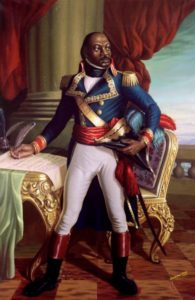
Back in Hispaniola, thing were actually looking up a little. Slavery was abolished, and the blacks were freed. A black man named Toussaint Louverture became the default leader of his realm. A literate man, Louverture banned slavery forever, and he preached equality between blacks and whites. A little over 150 years before Martin Luther King Jr., the people of Saint-Domingue were attempting to create an equitable multi-racial society between blacks and whites.
American leadership liked Louverture very much. They even asked him to formally declare independence from Revolutionary France. Yet Louverture simply couldn’t break his ties with the French revolutionaries, and this would end up being his undoing.
In 1801, Napoleon Bonaparte took power in France. In an attempt to restore France’s colonial empire, he re-took Saint-Domingue from the Jacobite French and the freed blacks. Toussaint Louverture eventually agreed to peace terms after an attempted standoff, and though he was promised a cushy retirement with his generals, he was eventually deported to France and thrown into a mountain jail where he would die a year later.
Haiti Became A Shithole
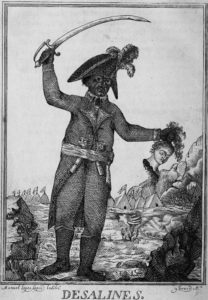 Once Napoleon thought he had control of the island of Hispaniola, he tried to bring back slavery. The blacks would not have it, and the French forces were eventually driven off, though many whites remained on the island.
Once Napoleon thought he had control of the island of Hispaniola, he tried to bring back slavery. The blacks would not have it, and the French forces were eventually driven off, though many whites remained on the island.
In the aftermath, a new leader took charge of Saint Domingue: General Jean-Jacques Dessalines. He began the year 1804 by first declaring independence. His secretary joked that to make the declaration authentic, they needed “the skin of a white for parchment, his skull for an inkwell, his blood for ink, and a bayonet for a pen.” Dessalines told his secretary to “make people know how I feel about the whites,” and to demonstrate his hatred for whites, he picked up the tricolor French flag and cut the white strip out of it, making it the new national flag for the newly-named country of Haiti.
Haiti’s Declaration of Independence was a tirade against France and French whites, signaling that a terrible act was soon to take place. Thomas Fleming covers this in his book, A Disease in the Public Mind:
The mere news of this declaration inspired not a few Frenchmen to charter ships to send their families and moveable property elsewhere. But when they arrived at various ports to embark, armed soldiers blocked their paths and ordered them to return to their homes.
General Dessalines had decided Haiti must be cleansed of everyone white. On March 9 he marched into the port of Jeremie and dragged every white male in the city into the town square. Dessalines gazed contemptuously at them and snarled: “You whites of Jeremie–I know how you hate me…The blood of you all shall pay!”
Five doctors, an American visitor, and a few foreign merchants were shoved to the other side of the square. Next Dessalines offered amnesty to about four hundred men of property if they would pay substantial ransoms before sundown. The rest were hacked to death by ax-wielding executioners. The four hundred reprieved men paid their ransoms well before sundown. But they were not released. During the night, they were all beheaded and their bodies left in a huge pile.
This style of brutality took place in the other cities on the island. Dessalines showed no mercy to any French man, woman, or child. In the end, Dessalines called on any remaining whites to emerge and be safely conducted to departing ships. Those who took him for his word were slaughtered.
Months after Dessaline’s murderous rampage, the illiterate general had the nerve to ask the United States for diplomatic relations. This, of course, was a preposterous joke. Dessalines was a madman who won nothing for Haiti except isolation from the rest of the world for generations to come. The United States refused to recognize Haiti’s independence, and the world would scorn the blood-soaked island from that day forward.
The American South Took Note of All This
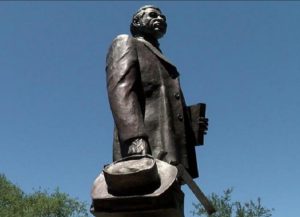
Thanks to the example of Haiti, America now had a grasp of the term “race war.” The fear of this possible future was clear in the minds of the Southern states. Should the South free its slaves, what were the chances that the slaves would take advantage of their former masters’ good will, as was seen in Dessalines’ betrayal of the gullible French citizens? Would Southern blacks take advantage of their newfound freedom and push forward with a full-on race war? At the time, it sure seemed like it, as chatter about the uprising in Haiti reached many slaves throughout the South.
In one example, in 1818 a black carpenter and former slave, Denmark Vessey, was well-acquainted with the Haiti story. Eager for action, he conspired with others to seize the arsenal in Charleston, South Carolina, arm their fellow blacks, and kill all the whites. After killing the slave owners and burning the city, they would grab a ship and sail to Haiti. On the planned day of insurrection–Bastille Day–Vessey told his followers “not to spare one white skin alive, as this was the plan they pursued in Santo Domingo.”
Vessey was swiftly caught and hanged with his conspirators. But the lesson for the South was clear, as Fleming explains:
The shock waves generated by the size and murderous intent of Denmark Vessey’s revolt sent shudders through the slave owners of the South. It validated everything they thought and imagined when they heard the words “Santo Domingo.”
In addition to these stoked fears, Haiti was a tremendous humiliation for President Thomas Jefferson. He was a huge fan of the French Revolution, and yet it was the Jacobins who disrupted the island and put the slave-inspiring Toussaint Louverture into power. When Bonaparte offered to restore French rule on the island, the fickle Jefferson said he would be happy to furnish his army and “reduce Toussaint to starvation.” Then, after Napoleon’s failure to retake the island, the world became witness to the extermination of Haiti’s whites. That fate of Haiti was partly due to President Jefferson–a man who, at one time, proposed a gradual emancipation of southern blacks. Yet now Jefferson would instead cynically ask: “Are our slaves to be presented with freedom and a dagger?”
Haiti, like many North American misadventures, was an opportunity squandered. The Haitian massacres led men to switch gears; instead of cheerfully and thoughtfully considering how to end slavery, thinkers were now trying to grasp what the ramifications of emancipation would be and why they should probably not follow through with the idea:
In the aftermath of the Haitian bloodbath, [professor of law, George Tucker] concluded that the “density” of a slave population was intimately connected wiht the likelihood of insurrections. The numerous revolts in the West Indies, where white-black imbalance frequently approached that of Saint-Domingue, was additional evidence supporting this conclusion.
Incendiary abolitionist propaganda and the reality of Caribbean slave revolts stifled most of the potential and hope for a peaceful end to slavery in America. Carried away in an emotional whirlwind, the hasty, knee-jerk actions of not a few people contributed to the stunted development – if not outright abortion – of bloodless emancipation in the United States. At this point, historians can only wonder in hindsight: how would things have gone if the Haitian uprising never happened?

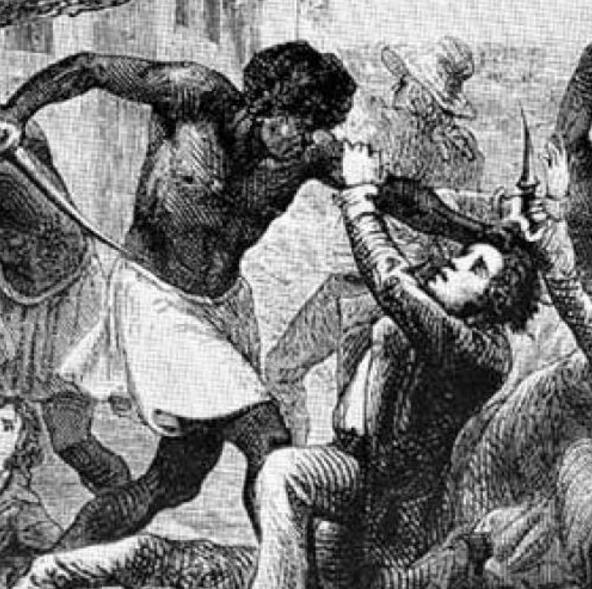







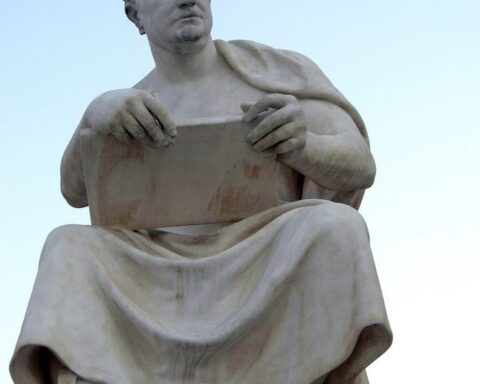
Fascinating what ifs.
5
0.5
How soon can a culture or nation be developed? The slaves of Haiti were most certainly gathered up from a plethora of tribes and nations of Africa and other slave-holding countries. But they banded together to overthrow the “whites”. In the absence of having a tribe (as is certainly the case when plucked from home and dropped off in chains in another land), does one demote to the more base level of race?
I believe this is the mistake of the pan-Africans, pan-Arabs, and pan-Whites. When surrounded by sufficient numbers of a nation to which one belongs, one does not think in terms of this more base level of black/white/yellow.
Or is this completely off base and there is a more simple moral in operation in the above story? These guys put me in chains. F them.
[…] Haiti Spooked the American South: Part 2 […]
[…] something less ancient. Consider Haiti (I wrote about this HERE and HERE.) This island, once called Hispaniola, was an island conquered by Spain and settled by […]
[…] Meet Rad Haiti Spooked the American South: Part 1 Haiti Spooked the American South: Part 2 A Roman Easter Story for Dejected Trump Voters Thomas Jefferson on America’s Expiration […]
[…] are slowly remembering what happened with Haiti (see HERE and HERE). Some of them are slowly remembering what happened to Rhodesia. Many are taking note of […]